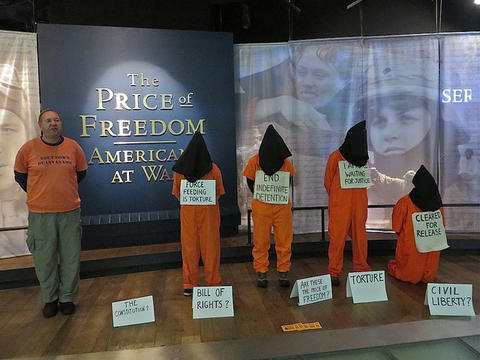Why Guantánamo Mustn't Be Forgotten in the Fallout from the CIA Torture Report

Witness Against Torture activists during the occupation of the Smithsonian National Museum of American History in Washington D.C. on January 11, 2014, the 12th anniversary of the opening of Guantánamo (Photo: Andy Worthington via Flickr).
By Andy Worthington, December 16, 2014
It's a week now since the 500-page executive summary of the Senate Intelligence Committee's 6,700-page report into the post-9/11 CIA torture program was published, and here at "Close Guantánamo," we are concerned that (a) the necessary calls for accountability will fall silent as the days and weeks pass; and (b) that people will not be aware that the use of torture was not confined solely to the CIA's "black sites," and the specific program investigated by the Senate Committee, and that it was a key element of the Bush administration's post-9/11 detention program -- in Afghanistan, in Iraq, and in Guantánamo, where elements of the current operations can still be defined as torture.
The Senate Committee report contains new information, of course -- much of it genuinely harrowing -- but journalists and researchers uncovered much of the program over the last ten years, and that body of work -- some of which I referred to in my article about the torture report for Al-Jazeera last week -- will continue to be of great relevance as the executive summary is analyzed, and, hopefully, as the full report is eventually made public.
Mainly, though, as I mentioned in the introduction to this article, it is crucial that the news cycle is not allowed to move on without an insistence that there be accountability. The Senate report chronicles crimes, authorized at the highest levels of the Bush administration, implemented by the CIA and two outside contractors, James Mitchell and Bruce Jessen, who had worked for a military program designed to train soldiers how to resist torture if captured, but who had no real-life experience of interrogations, or any knowledge of Al-Qaeda or the individuals involved (see Vice News' extraordinary interview with Mitchell here).
The use of torture is never allowed, as Article 2.2 of the U.N. Convention Against Torture, signed by Ronald Reagan in 1988 and ratified by the U.S. in 1994, makes clear. That article states, "No exceptional circumstances whatsoever, whether a state of war or a threat of war, internal political instability or any other public emergency, may be invoked as a justification of torture."
The Convention also makes it clear that torturers must be prosecuted. Following the publication of the executive summary, Ben Emmerson, the United Nations Special Rapporteur on the promotion and protection of human rights and fundamental freedoms while countering terrorism, called for prosecutions.
In a statement, he wrote, "The individuals responsible for the criminal conspiracy revealed in today’s report must be brought to justice, and must face criminal penalties commensurate with the gravity of their crimes. The fact that the policies revealed in this report were authorised at a high level within the U.S. Government provides no excuse whatsoever. Indeed, it reinforces the need for criminal accountability. International law prohibits the granting of immunities to public officials who have engaged in acts of torture. This applies not only to the actual perpetrators but also to those senior officials within the U.S. Government who devised, planned and authorized these crimes."
Kenneth Roth, the executive director of Human Rights Watch, has also called for prosecutions in a column for the Washington Post.
Torture at Guantánamo
As I also mentioned in the introduction to this article, we at "Close Guantánamo" are also concerned that people may fail to realize how torture was a key element in U.S. detention policy, post-9/11, in Afghanistan, in Iraq and at Guantánamo. Torture and abuse sadly replaced the Geneva Conventions after 9/11, in Kandahar and Bagram in Afghanistan, at Abu Ghraib and numerous other facilities in Iraq, leading to the deaths of over 100 prisoners, and at Guantánamo torture and abuse have also been rife throughout the prison's nearly 13-year history.
Most notoriously, Donald Rumsfeld, not to be outdone by the CIA program, implemented a torture program for one particular prisoner, Mohammed al-Qahtani, regarded as the intended 20th hijacker for the 9/11 attacks, whose use migrated -- being applied, between 2002 and 2004, to over 100 prisoners in total, who were subjected to an array of techniques including prolonged isolation, the use of loud music and white noise, the use of extreme heat and cold, forced nudity, exploitation of phobias, painful shackling, and what was euphemistically called the "frequent flier program," whereby prisoners were moved from cell to cell every few hours, to prevent sleep, for days, weeks or even, in some cases, months.
This torture program largely came to an end after the Supreme Court granted the prisoners habeas corpus rights at the end of June 2004, allowing lawyers to pierce the veil of secrecy that had enabled torture and abuse to proceed, almost unchecked, for over two years.
However, the punishment and isolation of prisoners regarded as significant and troublesome throughout the prison's history, up to and including the present day, is a largely unwritten story that will, hopefully, be exposed one day, as it will, I believe, expose how the treatment of these men -- who include Shaker Aamer, the last British resident in the prison -- has involved torture and unacceptable abuse.
Better known about is the abuse of hunger strikers, who are force-fed despite medical experts' condemnation of force-feeding as an unacceptable course of action to pursue with mentally competent prisoners -- see my article here about a letter written by 150 doctors condemning force-feeding during last year's prison-wide hunger strike at Guantánamo.
In addition, in June this year, speaking about Israel's plans to authorize the force-feeding of hunger-striking Palestinian prisoners -- in passages that could have been equally applied to hunger strikers at Guantánamo -- Juan Méndez, the U.N. Special Rapporteur on torture and other cruel, inhuman or degrading treatment or punishment, stated, "It is not acceptable to force-feed or use threats of force-feeding or other physical or psychological coercion against individuals who have opted for the extreme recourse of a hunger strike to protest against their detention without charge and conditions of detention and treatment. The desire of the inmates not to eat must be respected for as long as it is clear that they are making that choice voluntarily. Even if it is intended for the benefit of the detainees, feeding induced by threats, coercion, force or use of physical restraints are tantamount to cruel, inhuman and degrading treatment."
Another aspect of torture that is of particular relevance to the torture report is that 13 "high-value detainees," including notorious torture victims Khalid Sheikh Mohammed, Abu Zubaydah and Abd al-Rahim al-Nashiri, who were flown to Guantánamo from CIA "black sites" in September 2006, are not only still held, but have been gagged since their arrival, in an effort to prevent the outside world from hearing about their torture, and to prevent anyone from being held accountable for it (a 14th man, it should be noted, is the only one to have been transferred to the U.S. mainland, where he was tried and successfully convicted in federal court, in what should have been a model for all future prosecutions).
Apart from the partly censored transcripts of their Combatant Status Review Tribunals in early 2007 -- legally required for them to be assessed as "enemy combatants" and thereby made eligible for military commission trials -- their every exchange with their lawyers has remained classified. All exchanges between lawyers and prisoners are initially treated as presumptively classified, but in the cases of all the other prisoners, notes can be submitted to a Pentagon censorship board, which, with a semblance of fairness, decides what information can be unclassified and what should remain classified. In many of these other cases, much information has been unclassified -- often casting the authorities in a poor light -- but in the cases of the HVDs every word uttered remains classified.
In light of the torture report, questions must be asked about the dangerous and unacceptable cocoon of secrecy that still surrounds these men, just as it should also be noted that dozens more prisoners held at Guantánamo over the years -- many of whom are still held -- were also subjected to the CIA torture program in various "black sites," as well as, in some cases, in the outsourced foreign torture prisons -- in Jordan, for example -- in which the Senate report was not particularly interested.
For there to be an adequate follow-up to the torture report, the cases of all these men should be examined. This is in addition to a proper investigation of the stories of all the other prisoners whose torture and abuse took place solely in Bagram or other non-CIA prisons in Afghanistan, and in Guantánamo.
In conclusion, I'd like to remind readers that Guantánamo's final torture story concerns the very nature of detention at the prison -- for the most part, arbitrary, open-ended imprisonment without charge or trial. In establishing Guantánamo, the Bush administration did away with the requirement that you can only be deprived of your liberty if you are charged with a crime and given a federal court trial, or if you are a soldier, kept off the battlefield until the duration of hostilities, and treated humanely and in accordance with the Geneva Conventions.
This "war on terror," as we have learned, still may have no end, and trials, of course, have been forthcoming in very few cases. In fact, the authorities have openly stated that they are happy to imprison more people without charge or trial -- because they regard them as dangerous but don't have the evidence to prove it -- than they are to put men on trial, even in the military commission system that fails to meet internationally recognized standards of fairness and justice.
As well as being profoundly unjust, this system of indefinite detention without charge or trial can be severely damaging to the prisoners' mental health, as they have no idea when, if ever, they will be released -- and, as we must realize, there is no automatic mechanism that will lead to their release, and they are, in a very real sense, all political prisoners, to be freed only as the result of political maneuvering, and by no other means.
And the final horror? Well, the final horror is that, in October 2003 -- over eleven years ago, when Guantánamo had been open for less than two years -- a man called Christophe Girod, a senior representative of the International Committee of the Red Cross, told the New York Times, "One cannot keep these detainees in this pattern, this situation, indefinitely.'' He added, ''The open-endedness of the situation and its impact on the mental health of the population has become a major problem.''
I have returned to these comments time and again over the years, and for one simple reason: if arbitrary, open-ended detention was causing such mental health issues over eleven years ago, how almost unthinkably bad must it be now for so many men still held in Guantánamo, a prison that should never have been opened, and that, in light of the Senate torture report, needs closing as soon as possible.




